EARTHSCI FINALS COMPLETE
1/101
There's no tags or description
Looks like no tags are added yet.
Name | Mastery | Learn | Test | Matching | Spaced |
|---|
No study sessions yet.
102 Terms
Pacific Ocean basin
largest, deepest, and oldest existing ocean basin. More trenches, and more frequent tsunamis happen here. It has been shaped by plate tectonics.
Four Major Ocean Basins
North and South Pacific
North and South Atlantic
Indian
Arctic
Continental shelf
Partly shallow extension of the continent underwater.
Continental slope
Transition zone of continental shelf and deep ocean floor. It starts from oceanic crust to continental crust.
Continental rise
It is where the ocean begins. All basaltic and oceanic rocks are found here. It is the place where the sediments from land are washed. The continental margin starts from continental shelf up to continental rise.
Abyssal plain
The flattest part of the ocean. 50 % of the earth’s surface is being covered by this plain.
Island
It’s not just a piece of land floating up in the middle of the sea, it is part of the ocean basin that extends up from the ocean floor.
Seamount
It is an undersea mountain. The erosion caused by waves destroyed the top of a seamount which caused it to be flattened.
Trench
It is the deepest part of the ocean.
Mid-oceanic ridge
The seafloor mountain system which is situated in the middle of the ocean basin. It is where upwelling of magma happens which causes the sea floor to spread.
Wilson Cycle
explains the process of the opening (beginning) and the closing (end) of an ocean which is driven by Plate Tectonics.
J. Tuzo Wilson
Canadian Geophysicist that the Wilson Cycle is named after
6 Stages of the Wilson Cycle
Embryonic Ocean Basin
Juvenile Ocean Basin
Mature Ocean Basin
Declining Ocean Basin
Terminal Ocean Basin
Suturing
Embryonic
Motion: Uplift
Complex system of linear rift valleys on continent
e.g. East African Rift Valleys
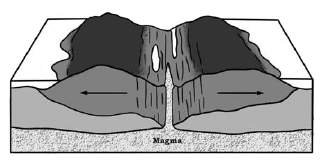
Juvenile
Motion: Divergence (Spreading)
Narrow seas with matching coasts
e.g. Red Sea
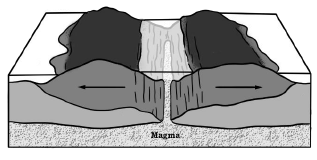
Mature
Motion: Divergence (Spreading)
Ocean basin with continental margins
e.g. Atlantic and Arctic Oceans
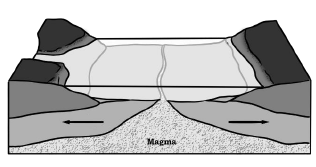
Declining
Motion: Convergent (Subduction)
Islands arcs and trenches around basin edge
e.g. Pacific Ocean
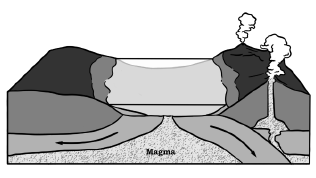
Terminal
Motion: Convergent (Collision and Uplift)
Narrow, irregular seas with young mountains
e.g. Mediterranean Seas
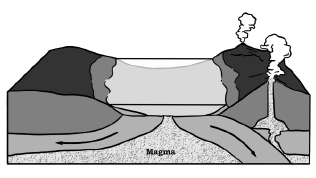
Suturing
Motion: Convergence and Uplift
Young to mature mountain belts
e.g. Himalayas Mountains
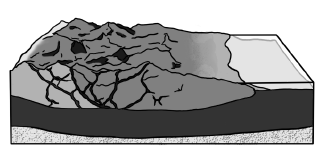
Metamorphism
is one of the geologic processes in which rocks change in form, composition, and structure due to intense heat and pressure and sometimes with the introduction of chemically active fluids.
Geothermal gradient
The rate at which temperature increases with depth in the Earth’s crust
varies on plate tectonic settings like the thickness of the crust or whether the area is in the subduction zone between oceanic and continental or under the converging two continental crusts.
Factors involved in metamorphism
Temperature
Pressure
high-pressure metamorphism
metamorphism in the subduction zone is characterized by
moderate-pressure metamorphism
the collision zone between two continental crusts is marked by
Vertical Stress
is the stress or pressure exerted on the rock by the weight of overlying material such as in burial metamorphism. This type of pressure is the same in all directions and makes the rocks to fracture or deform.
Differential Pressure
is imposed by a force in a particular direction
guides the shape and orientation of the new crystals formed as minerals recrystallize under the influence of both heat and pressure. This results in a textural change such that the minerals are elongated in the direction perpendicular to the directed stress and this contributes to the formation of foliation.
Foliation
is a set of flat or wavy parallel cleavage planes produced by deformation under directed pressures
Serpentinization
Metamorphism caused by hydrothermal fluids also occurs in mid-ocean ridges where hot lava, coming out of the fissures, reacts with mineral-rich ocean water. This causes serpentines to form through oxidation and hydration chemical reaction of peridotites- olivine-rich rocks at the base of the oceanic crust.
Regional Metamorphism
forms foliated metamorphic rocks such as Gneiss and Schist due to high temperature and pressure imposed on large parts of the crust.
Contact Metamorphism
which is prominent in areas where surrounding rocks are exposed to heat coming from magma intrusion within the layers of the rocks. Marble, quartzite, limestone, and other granoblastic rocks with large visible crystals of minerals may be formed through contact metamorphism.
Shock Metamorphism
which takes place when the heat and shock waves from meteor or asteroid impact transform rocks immediately around the impact site. Examples of this are the transformation of mineral graphite into ultra-high-pressure polymorph diamond and the conversion of quartz minerals into coesite under high shock pressures.
Burial Metamorphism
occurs at lower temperature and pressure which transforms sedimentary rocks that had undergone diagenesis into low-grade metamorphic rocks through relatively low temperature and pressure. Partial alteration of the mineralogy and texture may occur while other sedimentary structures are usually preserved.
Tensional stress
type of stress
causes rocks to be pulled apart that result to lengthening and break apart. This type of stress can be found at divergent plate boundaries.
Compressional stress
type of stress
causes rocks to fold or fracture. It squeezes rocks together. Compression is the most common type of stress in convergent plate boundaries.
Shear Stress
type of stress
happens when forces slide pass each other in opposite direction which results to slippage and translation. This is the most common stress found in transform plate boundaries
Faults
rock under ample stress can crack, or fracture. The fracture is called a joint because there is a block of rock left standing on either side of a fracture line.
Footwall
rock that is below the fault.
Normal faults
are the most common faults at divergent boundaries. In relation to the footwall, it develops as the hanging wall drops down.
East African Fault
example of a normal fault
Reverse faults
This type of fault is most common at the convergent boundaries. It forms when the hanging wall moves up.
Strike-slip faults
This type of faults formed when the walls move sideways. It can be either right lateral or left lateral. It is mostly common on transform plate boundaries
Himalayas and Rocky Mountains
Mountain ranges created by reverse faults
San Andreas Fault
example of a strike-slip fault
SONAR
a device that bounces sound waves off underwater objects and then record the echoes of these sound waves
Magnetometer
were attached to ships and allowed scientists discovered a lot about the magnetic properties of the seafloor.
Harry Hess
explained how the convection currents in the Earth’s interior make the seafloor spread.
Convection current
carry heat from the molten materials in the mantle and core towards the lithosphere. These current ensures that the “recycled” materials formed in the lithosphere were back to the mantle.
Molten materials, magnetic strip, drilling sample
Three evidence of seafloor spreading
Evidence from molten materials
Evidence for seafloor spreading
rocks shaped like pillows (rock pillows) show that molten materials have erupted again and again from cracks along the mid-ocean ridge and cooled quickly.
Evidence from magnetic strip
Evidence for seafloor spreading
rocks that make up the ocean floor lie in a pattern of magnetized stripes which hold a record of the reversals in magnetic field
Evidence from drilling sample
Evidence for seafloor spreading
core samples from the ocean floor show that older rocks are found farther from the ridge; youngest rocks are in the mid-ocean ridge
Hanging wall
rock that is placed on top of a fault
Weathering
the breaking down or alteration of rocks and minerals on Earth’s surface
Physical Weathering
the breaking down of rocks and minerals without changing its chemical composition
Frost Wedging
happens when water filling a crack freezes and expands, which in turn exerts pressure against the rock until it breaks
Salt Crystal Growth
happens when a salt in a solution precipitates in fractures of rocks which in turn exerts pressure to break it
Abrasion
happens when a rock or sediments bump into another rock causing its break down
Biological Activity
break down of rocks due to plant and animal activity
Exfoliation
breaking down of rocks that happens due to the reduction of pressures
Heat and Cold Cycles
breakdown of rock that happens due to its contraction and expansion after exposure to hot and cold cycles
Chemical Weathering
the breaking down of rocks and minerals caused by chemicals in rain or moving water
leads to rock’s change in chemical composition or weakening of its structure
Dissolution
happens when soluble minerals found in rocks are dissolved by water
Hydrolysis
breakdown of rock caused by its reaction with water
Oxidation
breakdown of rock by oxygen and water often giving iron rich rocks a rusty colored weathered surface
Factors Affecting Weathering
Properties of rocks
Climate
Soil and Vegetation
Length of Exposure
Primordial Heat
INTERNAL HEAT SOURCE
Earth was formed through accretion, where gravitational energy attracted gasses and dust from clouds, forming planetisimals. Heat was generated during this process, forming the earliest stage of Earth. Heat remained trapped in the core, causing convective and conductive transport to the mantle and surface, preserving some primordial heat.
Heat from the decay of radioactive elements
INTERNAL HEAT SOURCE
Earth's internal heat is primarily generated by radioactive decay, a process where naturally occurring isotopes decay, such as potassium-40, Uranium-235, Uranium-238, and Thorium-232. Other radioactive isotopes, though minor in production, contribute to the Earth's cooling process, despite their low heat capacity.
Dense core material
INTERNAL HEAT SOURCE
• Earth's inner core, composed primarily of iron and nickel, has a density between 12,600-13,000 kg/m3.
• Other heavy elements like gold, platinum, palladium, silver, and tungsten are also present in the core.
• The intense pressure in the inner core prevents the melting of iron and other elements, contributing to intense heat in the planet's interior.
Gravitational Pressure
INTERNAL HEAT SOURCE
As one descends into Earth's interior, pressure increases due to the weight of overlying rocks.
Near the center, pressure is 3 to 4 million times the pressure of the atmosphere at sea level.
Rocks act as good insulators, reducing heat escape from Earth's surface.
High temperatures cause beneath material to melt towards the central part of the earth, acquiring solid properties and possibly a plastic state.
Partial Melting
takes place because rocks are not pure materials. As temperature rises, some minerals melt and others remain solid. If the same conditions are maintained at any given temperature, the same mixture of solid and melted rock is maintained.
Decompression melting
takes place within Earth when a body of rock is held at approximately the same temperature but the pressure is reduced.
Flux melting
happens if a rock is close to its melting point and some water or carbon dioxide is added to the rock, the melting temperature is reduced and partial melting starts.
Intrusion
magma that moves up into a volcano without erupting. Like a balloon, this causes the volcano to grow on the inside.
Plutonism
refers to all sorts of igneous geological activities taking place below the Earth's surface
Plutonites
When the process of crystallization takes place inside the crust, the magmatic rocks produced
are igneous rock formations that are created when the process of crystallization and solidification of magma takes places below the Earth's surface and particularly in the crust
Extrusion
is an eruption of magmatic materials that causes land formation on the surface of the Earth.
Volcanism
is used to describe all geological phenomena that occurs on the natural terrestrial surface, such as the creation of volcanoes and hot springs.
It refers to all sorts of geological activities correlated with the flow and transportation of igneous material from the planet's interior towards the natural terrestrial surface.
Tectonic plate
is a massive, irregularly shaped slab of solid rock
Collision
motion of plates
wherein two continental plates are moved toward each other.
Subduction
motion of plates
when one plate subsides beneath the other plate.
Spreading
motion of plates
occurs when two plates are move away from each other
Transform faulting
motion of plates
occur when two plates slide past each other.
Convergent plate boundaries
occur when two plates collide, with subduction zones occurring when oceanic crust is subducted underneath. This results in island arcs, oceanic trenches, and back-arc basins. When oceanic crust meets continental crust, the denser oceanic plate subducts, creating mountain ranges like the Andes. Continental crust collides with another to create large mountain ranges.
Divergent plate boundaries
occur when two plates move away from each other, creating space filled with new material from molten magma below Earth's surface. These boundaries can form within continents but may eventually open into ocean basins. Within continents, they produce rifts or valleys, with the most active divergent plate boundaries occurring between oceanic plates, known as mid-oceanic ridges or underwater mountain ranges.
Transform Plate Boundaries
are where plates slide passed each other. The relative motion is horizontal. It can occur underwater or on land. In the process, the crust is neither destroyed nor created. Due to this friction, the plates cannot simply glide past each other. As a result, stress builds up in both plates. When it surpasses the threshold of the rocks, energy is released which can cause earthquakes.
The Majesty of Petra
One of the New Seven Wonders of the World located in Jordan. Its two most significant attractions are the Treasury and Monastery which are massive temples carved into the side of sandstone cliffs.
Sandstone
a sedimentary rock composed of sand-size grains of mineral, rock, and organic material.
Sedimentary Rocks
edimentary rocks are rocks
formed from sediment - material
consisting of sand, gravel, mud,
ions in solution deprived from pre-
existing rocks or organic debris
from living organisms.
Stratification
It is the process leading to the
formation or deposition of layers,
especially of the sedimentary rocks. The
layers range from several millimeters to
many meters in thickness and vary
greatly in shape. Strata may range from
thin sheets that cover many square
kilometers to thick lens like bodies that
extend only a few meters lateral.
Law of Superposition
is a basic law of geochronology, stating that in any undisturbed sequence of rocks deposited in layers, the youngest layer is on top and the oldest on bottom, each layer being younger than the one beneath it and older than the one above it.
Law of Original Horizontality
states that layers of sediment were originally deposited horizontally under the action of gravity. It suggests that all rock layers are originally laid down (deposited) horizontally and can later be deformed.
The Law of Lateral Continuity
states that the layers of rock are continuous until they encounter other solid bodies that block their deposition or until they are acted upon by agents that appear after deposition takes place such as erosion and fault movements.
Relative Dating
Used to determine the age by comparing the historical remains to the nearby layers. It is a less advanced technique when compared to absolute dating.
Stratigraphy
Relative Dating
This technique assumes that the lowest layer is the oldest while the topmost layer is the youngest layer. It is one of the oldest methods of relative dating.
Biostratigraphy
Relative Dating
In this technique, the faunal deposits such as fossils of dead animals are used to establish a strategy for dating. It is an extended version of the stratigraphy.
Cross dating
Relative dating
In this method, the fossils of one layer are compared with another layer with known dating.
Absolute Dating
Also called numerical dating. It is a technique that determines the exact numerical age of a historical remaining
Radiometric Dating
Absolute Dating
It determines the age of the sample by measuring the amount of a particular radioactive isotope present in the sample. The age can be determined by the rate of decay of that isotope.
Amino Acid Dating
Absolute Dating
The change in the protein content of a biological sample can be used to determine the age. A particular form of living being may have a defined protein content in their bodies that deteriorates with time.